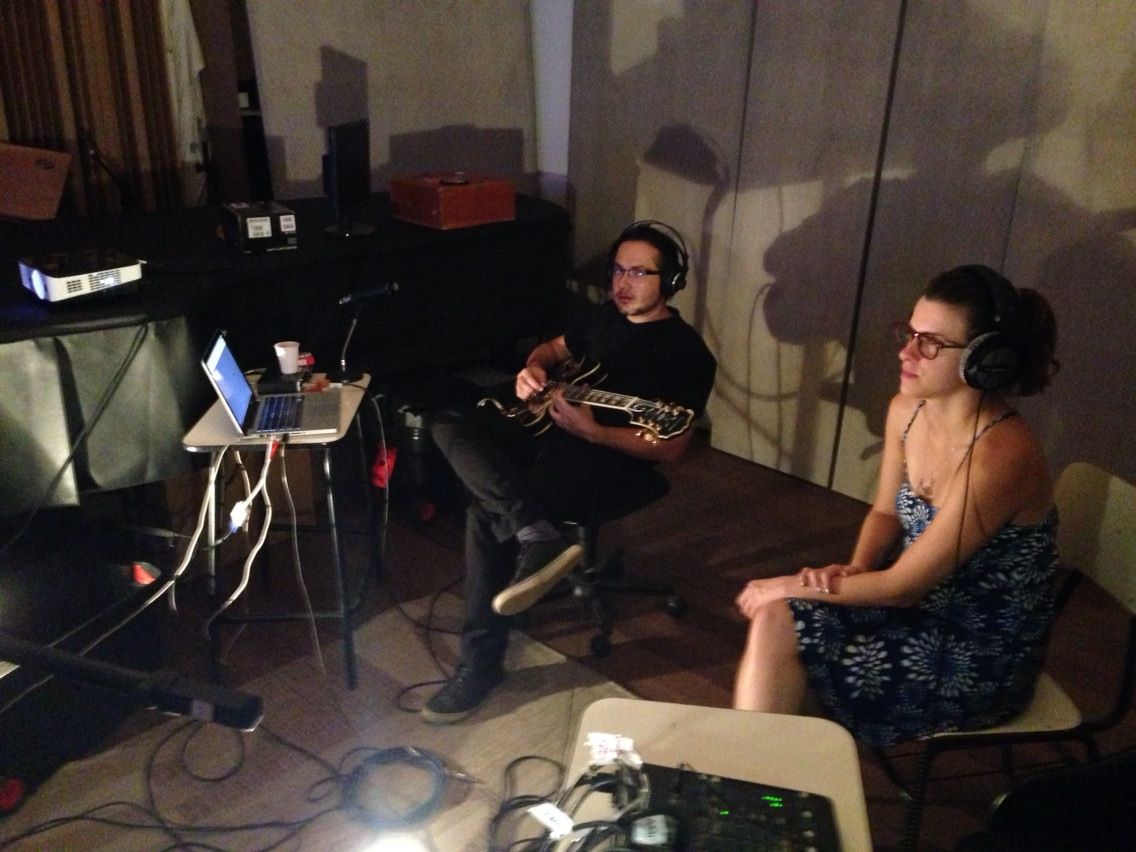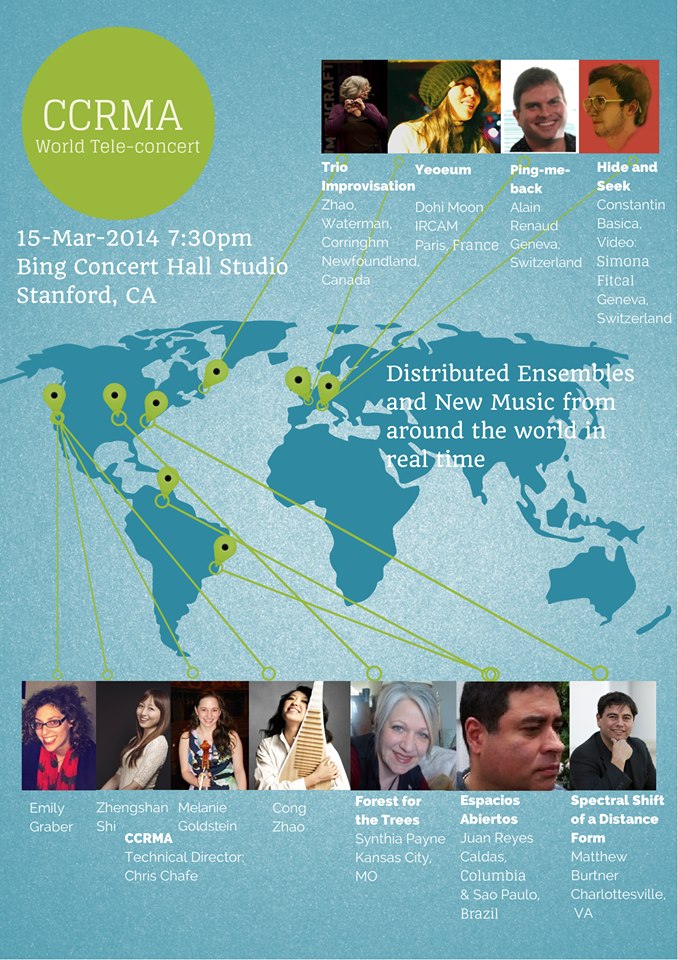CCRMA TeleConcert
CCRMA TeleConcert
15-Mar-2014 7:30pm
Bing Concert Hall Studio
Distributed Ensembles and New Music
from around the world in real time


Constantin Basica, Simona Fitcal
computer music, stereo video, cello, remote prepared electric guitar
——–
cello Melanie Goldstein
——–
(Geneva, Switzerland) prepared electric guitar Victor Coltea
tech Alain Renaud
Yeoeum
Dohi Moon
piano, computer music, remote saxophone
——–
disklavier piano
——–
(Paris, France IRCAM) saxophone Joachim Badenhorst
techs Jean Bresson, Melina Avenati, Laurent Ghys
Ping-me-back
Alain Renaud
network delay, violin, remote computer effects
——–
violin Emily Graber
——–
(Geneva, Switzerland ) computer Alain Renaud
tech Alain Renaud
Trio Improvisation
Zhao, Waterman, Corringham
pipa Zhao Cong
——–
(St. Johns, Newfoundland, Memorial U.) flute Ellen Watermna
vocals Viv Corringham
techs Michelle Lacour, Rich Blenkinsopp
Espacios Abiertos
Juan Reyes
computer music, video, accordian, remote viola, remote electric guitar, remote vocals
——–
accordian Zhengshan Shi
——–
(Manizales, Colombia, Caldas U., Laboratorio Sensor)
techs Mario Valencia, Santiago Rubio
——–
(Sao Paulo, Brazil, ECA, Universidade de Sao Paulo, Nucleo de Sonologia) electric guitar, Julian Jararmillo
vocals Lilian Campesato
Spectral Shift of a Distance Form
Matthew Burtner
saxophone, cellos, remote cellos
——–
saxophone Matthew Burtner
cello Melanie Goldstein
cello Naoya Kanoi
——–
(Charlottesville, VA, U. Virginia) cello Kevin Davis
cello Phillip Munck
tech Jon Bellona
Forest for the Trees
Synthia Payne
piano, pipa, violin, remote electric guitar, vocals, saxophone
——–
piano Zhengshan Shi
pipa Zhao Cong
violin Emily Graber
——–
(Kansas City, MO) electric guitar Monte Taylor
saxophone Justin Balk
vocals Synthia Payne
Program Notes
Constantin Basica
Hide and Seek
Computers, internet, and video games offer children nowadays a digital childhood. The traditional outdoor play is replaced by immersive online games. The border between real and virtual becomes more and more transparent. A guitarist plays hide and seek with a cellist, but the rules are changed: the Internet is the playground, and they cannot see or hear each other, because one is hidden in the room, while the other is in a different city.
Dohi Moon
Yeoeum
Almost every movie or theater play presents us with multiple parallel stories intertwined. Yet we see one plot. As an audience we see actors/actresses, which do not know the whole plot (at least they pretend to). They cannot know what happened to the other protagonists in different locations of the plot. I thought about this situation as a basis for a new composition for a network performance. This piece has two different parts, a fixed composition for disklavier + electronics and an improvisation part for a tenor saxophone performer who is connected over the internet. The other focus of the piece is to bring out the uniqueness of the instruments, the mechanical movements from the disklavier, microtonal electronics, and the improvised tenor saxophone. The tenor saxophone performer is playing with only a structural score, which determines a contour for the tenor saxophone part with dynamics, pitch, rhythm, and time indications, while the disklavier and electronics are playing the fixed score. The improviser will construct his own musical voice following the structural score without knowing the other parts, but when he starts to play with the disklavier and electronics, he will need to improvise his role in the gross contour of the disklavier+electronics: he will decide to take over, mingle, imitate, or support the disklavier and electronics in each moment, while he is playing.
Yeoeum means the sound of ringing in memory even after it disappears.
Alain Renaud
Ping-me-back
This piece takes the signal of a live musical instrument in Stanford and processes it through the network, mostly by analyzing the latency between a variety of web hosts around the world. The live signals is transformed into grains equaling to the latency resulting from the path the signal takes between various web hosts. Sometimes, the signal is randomly leaked into a real physical space in Geneva and recaptured and re-injected into the network of nodes leading to an increased space audition. The processed signal resulting from the grains and the interplay between virtual and physical is sent back to Stanford. A simple visual interface cues the live instrument in Stanford when some new live sound material needs to be fed to the network, creating an interesting “ping-pong” interplay and the ability to hear the network.
Juan Reyes
Espacios Abiertos
'Espacios Abiertos' is a piece for singing Tibetan bowls in the form of a soundtrack rendered from physical models, in addition to scattered improvisations on different geographical listening spaces. Originally a video installation, in its real-time performance, visuals follow a pattern of blue stills with subtle changes as time goes by. - "In an open space, the point of light, the sounds, come from a distant horizon, seeking our senses from afar", Rodrigo Orrantia (co-author).
Matthew Burtner
Spectral Shift of a Distance Form
Spectral Shift of a Distance Form (2014) for tenor saxophone, distance cellos and computer explores the spectral and spatial evolution of a sonic form. Tenor saxophone sonorities are transformed by the computer and spatialized around the audience in a six-channel mix. Distance cellos, retuned to match the microtonal saxophone multiphonics, receive specific partials of the saxophone sound and respond according to the score. The reconstructed microtonal structure wraps around the audience and shifts gradually. Spectral Shift of a Distance Form was composed for CCRMA and is inspired by my piece, Portals of Distortion (1998) for nine tenor saxophones, written when I first arrived at Stanford as a graduate student. The piece also draws inspiration from Richard Serra’s sculptures, such as the Torqued Ellipses, shapes that feel static and tense, and that extend beyond the viewer’s immediate reach.
Synthia Payne
Forest for the Trees
Six musicians in two separate locations via Internet2 and Google Fiber. What happens when people have a finite amount of time and limited visual reference to find out what is going on around them and signal their presence? Listen and see. Each musician is a tree in the ecosystem of the forest, however, in this case especially, they cannot see the entire forest they are a part of. Each instrument take a turn with a 5 second solo sounding. Other players listen deeply to the sound of each instrument. The forest is a drone. Everyone begin a drone together and over a minute or so study the other sounds. Begin to use embellishments to mimic another instrument. Come back to the drone after each mimicking. Players map their own path, which can repeat, backtrack, whatever, no rules.
